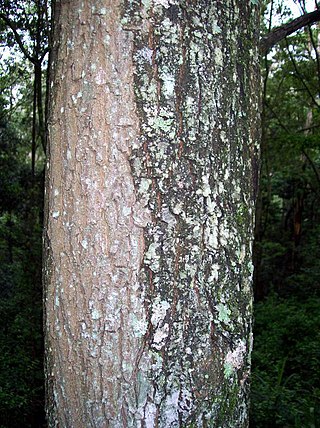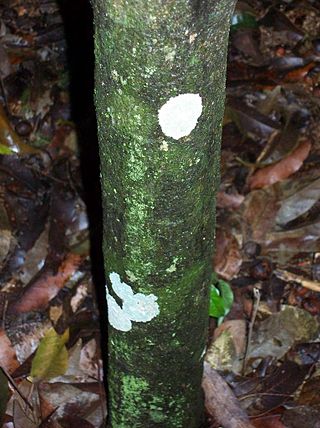
Trochocarpa laurina is an Australian shrub or small tree. It occurs from near Bermagui in southern coastal New South Wales to the Wet Tropics in Queensland. It grows at the summit of Mount Bellenden Ker, which has an average annual rainfall of 8312 mm. The minimum annual rainfall requirement is 1200 mm.

Hedycarya angustifolia, also known as the native mulberry or Australian mulberry, is a rainforest plant of south and eastern Australia. Its habitat is cool gullies and moist temperate forests, often at high altitude. Occasionally it is seen bordering sclerophyll forests.

Cryptocarya laevigata, known as the glossy laurel or red-fruited laurel, is a rainforest plant, which ranges from Malesia and New Guinea to eastern Australia. In Australia it grows in the rainforest understorey on fertile soils, from the Richmond River, New South Wales to Cairns in tropical Queensland, where it is often seen in association with the White Booyong.

Cryptocarya foveolata, known as the mountain walnut is a rainforest tree growing at high altitude in eastern Australia. Despite the common name, it belongs to the laurel family.

Endiandra pubens is a rainforest tree growing in eastern Australia. The habitat is subtropical rainforest growing near streams in valleys. The range of natural distribution is from the Bellinger River, New South Wales to Bulburin National Park, south west of Gladstone, Queensland.

Croton verreauxii known as the green native cascarilla is a small tree or shrub growing in dry rainforest and rainforest margins in eastern Australia.

Psychotria loniceroides, the hairy psychotria, is a plant native to the forest areas of eastern Australia.

Notelaea venosa is a very common shrub or small tree in eastern Australia. Occurring in or adjacent to rainforest from Lakes Entrance, Victoria to Cunninghams Gap in south eastern Queensland. Common names include veined mock-olive, smooth mock-olive, large-leaved mock-olive and large mock-olive. Often seen in the bushland areas in Sydney.

Telopea oreades, commonly known as the Gippsland-, mountain- or Victorian waratah, is a large shrub or small tree in the family Proteaceae. Native to southeastern Australia, it is found in wet sclerophyll forest and rainforest on rich acidic soils high in organic matter. No subspecies are recognised, though a northern isolated population hybridises extensively with the Braidwood waratah (T. mongaensis). Reaching a height of up to 19 metres, T. oreades grows with a single trunk and erect habit. It has dark green leaves with prominent veins that are 11–28 centimetres (4.3–11 in) long and 1.5–6 cm (0.6–2.4 in) wide. The red flower heads, known as inflorescences, appear in late spring. Each is composed of up to 60 individual flowers.

Clerodendrum tomentosum, known as the downy chance, hairy lolly bush, hairy clairy or hairy clerodendrum is a shrub or small tree occurring in eastern and northern Australia. Distributed from Batemans Bay in southern coastal New South Wales, Queensland, Northern Territory, Western Australia, and New Guinea.

Notelaea longifolia is a very common shrub or small tree in eastern Australia. Occurring in or adjacent to rainforest from Mimosa Rocks National Park to Bamaga in far north Queensland. Common names include large mock-olive or long-leaved-olive. An attractive ornamental plant.

Bridelia exaltata, known as the brush ironbark or scrub ironbark, is a tree of eastern Australia. It occurs in and on the margins of the drier rainforests. Also occurring by streams, often in association with the Black Bean, up to an elevation of 600 metres above sea level. It occurs from Seal Rocks, New South Wales to Maryborough, Queensland.

Cyclophyllum longipetalum, known as the Coast Canthium is a shrub or tree occurring in eastern Australia. Commonly seen growing in a variety of different rainforest situations. From Lake Conjola in southern New South Wales to Fraser Island in south eastern Queensland.

Endiandra compressa, the white bark, is a rainforest tree growing in eastern Australia. The habitat is rainforest growing near streams in valleys. The range of natural distribution is from the Nambucca River, New South Wales to Kutini-Payamu National Park, in north Queensland.

Endiandra hayesii is an Australian rainforest tree. Despite the common name of rusty rose walnut, this tree is unrelated to northern hemisphere walnuts, and is a laurel. The former habitat is lowland sub tropical rainforest, most of which has been cleared. However some trees persist in cool sheltered gullies as far south as the Richmond River, New South Wales to just over the border at Burleigh Heads in Queensland. The rusty rose walnut is considered rare, with a ROTAP rating of 3RC-. It is named after H.C. Hayes, who collected this species at Minyon Falls.

Endiandra introrsa is a rare rainforest tree growing in eastern Australia. Listed with a Rare or Threatened Australian Plants (ROTAP) rating of 3RCa. Its habitat is warm temperate rainforest on the poorer rainforest soils, mostly over 300 metres in altitude, and its range of natural distribution is from near Dorrigo to various sites in the state of Queensland.

Ochrosia moorei, known as the southern ochrosia is a rainforest plant of eastern Australia. Endangered by extinction, it has a ROTAP rating of 2ECi.

Petalostigma triloculare, known as the long-leaved bitter bark is a rainforest tree of eastern Australia. It occurs in the drier rainforests, often on sandy soil derived from granite or sandstone, and is sometimes seen on old sand dunes.

Myoporum acuminatum, commonly known as waterbush, pointed boobialla or mangrove boobialla, is a flowering plant in the figwort family Scrophulariaceae and is endemic to eastern Australia. It grows in rainforest or wet eucalyptus forest near the coast and in the Coastal Ranges, and is occasionally associated with mangroves. Occasionally it is found in the drier rainforests. It grows naturally as far south as Mimosa Rocks National Park in far south eastern New South Wales, and north to Fraser Island in Southern Queensland.

Litsea australis, the brown bollygum or brown bollywood is a species of rainforest tree in the laurel family, found in eastern Australia. The specific epithet australis means "southern". As this southern population was considered to be Litsea leefeana, until reclassified by the rainforest botanist Bernie Hyland in 1989. This species is found in a variety of different rainforest types, but often seen growing near the sea. Distributed from Forster, New South Wales in the south to Fraser Island in Queensland.



















